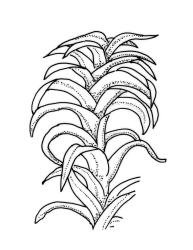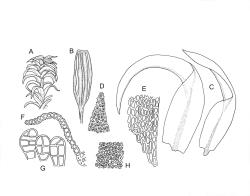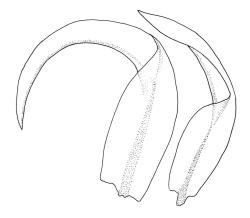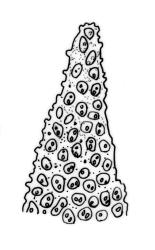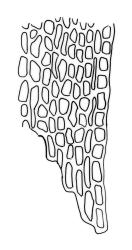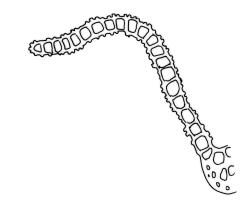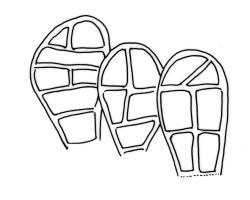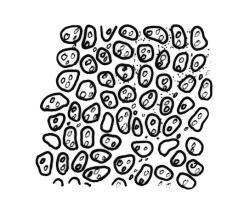- ≡ Orthotrichum rufescens Hampe, Ann. Sci. Nat., Bot. sér. 5, 4: 334 (1865)
- ≡ Ulota rufescens (Hampe) A.Jaeger, Ber. Thätigk. St. Gallischen Naturwiss. Ges. 1872–1873: 163 (1874)
- = Zygodon vestitus R.S.Williams, Bull. New York Bot. Gard. 3: 127 (1903)
- = Zygodon persquarrifolius Dixon in Sainsbury, Trans. & Proc. Roy. Soc. New Zealand 75: 176 (1945) nom. nud.
Plants medium-sized to robust, yellow-green above, red-brown below. Stems unbranched or sparsely branched (apparently by innovation, but perhaps also by forking), mostly c. 7–20 mm., in cross-section with small incrassate cortical cells, thick-walled internal cells, and lacking a central strand; rhizoids well-developed, numerous on lower stems, sometimes extending nearly to stem apex, brown, finely papillose. Leaves loosely erect-contorted (not secund) when dry, strongly spreading-squarrose when moist, weakly or not undulate, lanceolate to ovate lanceolate, acute or acuminate, somewhat decurrent, c. 1.4–2.0 × 0.3–0.4 mm (longer leaves near stem apex); margins plane, entire (except for projecting papillae); upper laminal cells irregularly rounded, almost isodiametric (but shape obscured by papillae), not differentiated at margins, with 3–5 short, single papillae on both surfaces, 6–9.5 µm diam.; apical cells sometimes hyaline and smooth; basal cells rectangular or rhomboidal, moderately thick-walled, smooth, sometimes red-brown, grading abruptly into the papillose cells above. Costa stout, c. 35–45 μm wide in lower leaf, yellow-brown, ending below the apex, with cells on both surfaces elongate, weakly papillose abaxially in upper half. Gemmae borne in clusters on axillary stalks, broadly ovoid, mostly 54–70 × 30–35 μm, 5–6-celled, with two transverse and 1–2 longitudinal walls. Laminal KOH colour reaction positive red or yellow then red (also in costa and stem).
Apparently dioicous (only ♀ plants seen from N.Z). Perichaetia apparently terminal and over-topped by innovations, with many archegonia and paraphyses; perichaetial leaves narrowly lanceolate, longer than vegetative leaves (c. 2.2 mm). Setae c. 3.5–8 mm long, dextrorse above; capsules exserted, cylindric, orange-brown, deeply furrowed along the entire length when dry, c. 1.5–2 mm long. Operculum not seen. Peristome and calyptra not seen. Spores globose, coarsely papillose, green, 15–21 μm.
Malta 1926, fig. 46 (as Z. vestitus); Lewinsky 1990, figs 182–198.
NI: S Auckland (Kaingaroa Plains, near Taupō); Hawke’s Bay (Tarawera); SI: Marlborough (Black Birch Range), Canterbury (Cass, Hawdon River), Otago (Ōtōkia); St (Port William).
Lewinsky (1990) recorded this species from Paradise (Otago L.D.) based on a J. Child collection in BM but this specimen has not been sighted.
Anomalous. Lewinsky (1990) gave the world distribution as N.Z., Bolivia, and Colombia.
This is a rarely collected species. It is recorded as an epiphyte on Griselinia littoralis, Leptospermum scoparium, and Cordyline australis, as well as on Salix. A collection from an unidentified trunk at Port William included Calyptopogon mnioides, Camptochaete angustata, Syntrichia serrata, Z. intermedius, and Metzgeria sp. There are few reliable elevation data. Material from the North I. appears to come from between c. 250 and c. 500 m. The single Marlborough specimen, the best documented from the South I., is from 900 m, while the Ōtōkia collection almost certainly came from below 100 m elevation.
The only South American material examined is an isotype of Z. vestitus R.S.Williams from Sorata, Bolivia. I agree with Lewinsky (1990) that "the variation between the South American and New Zealand specimens is not large". The upper abaxial surface of the costa in the Bolivian material is smooth in contrast to N.Z. material, which is weakly papillose. The leaves of the Bolivian material are slightly longer than those of N.Z. material. The dentation near the leaf base mentioned by Lewinsky for Bolivian material has not been seen.
Lewinsky (1990) noted three mature but incomplete sporophytes in Martin's collection from Stewart I.; she gave the setae as c. 8 and the capsule as c. 2 mm long. The only capsule seen in a collection from Black Birch Range by P. Beveridge (CHR 555561, a duplicate of WELT M035567) has a shorter (c. 3.5 mm) seta and capsule (1.5 mm), and abundant spores.
The Bolivian material seen (WELT M040252) has three setae each 5 mm long and inoperculate capsules each c. 2 mm long (including the neck). Malta (1926, p. 88) quoted R.S. Williams, giving the peristome of Z. vestitum as "of 8 cilia".
Malta (1926) tentatively treated Z. vestitus and Z. rufescens as separate taxa, but he had not seen sporophytes of the latter taxon. Lewinsky’s (1990) judgement that the South American name Z. rufescens (Hampe) Broth. should be applied to N.Z. material followed that of Sainsbury (1945; 1955) and is accepted here.
Despite being poorly documented, the relatively robust habit (shoots of Z. rufescens are c. 2.0–2.5 mm wide vs c. 2.0 mm for Z. intermedius), strongly spreading-squarrose leaves, and gemmae with both transverse and longitudinal septa make Z. rufescens a distinctive species in a N.Z. context. Glenny et al. (2011) ranked the threat status of Z. rufescens as naturally uncommon and data deficient.



